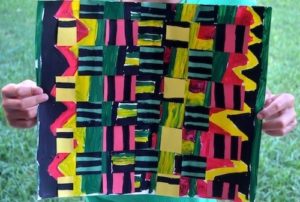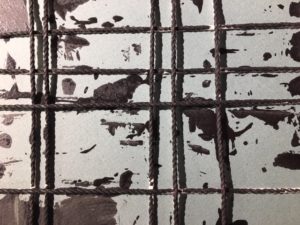African Kente Cloth Weaving
Objective: This multicultural project takes us to Africa and explores the significance of the Kente Cloth. The Kente Cloth was originally worm by royalty, the very wealthy, or highly respected Ashanti people people of Ghana in West Africa. Today it is worn by all, especially for special occasions such as festivals, ceremonies and holidays. These textiles, while certainly beautiful to look at, are important because of the deep meaning and significance of the patterns and colors:
- Red – passion, bloodshed, and death
- Purple – femininity, healing, and protection
- Green – planting, growth, and good health
- Gold – royalty and wealth
- Black – maturity and strength
- Blue – peace, love, and harmony
- White – purity and healing
- Yellow – beauty and holiness
Materials: Paint, paintbrushes, scissors, colored construction paper, thick white paper (wooden block/ cardboard and yarn if adding printmaking element)
Directions:
- View images of the Kente Cloth. Notice the use of geometric shapes, bold lines and patterns.


- Paint your designs onto the white paper in a similar fashion using your chosen colors. Stick with geometric designs such as stripes, squares, diamonds, triangles, etc… Remember that the colors you choose are significant to the meaning of your “cloth.”
- Paint in all the space so there is no remaining white visible. Allow to dry completely.Using black paint, paint simple lines onto a few pieces of colored construction paper. (Stick with simple stripes and zig-zag patterns.) Allow to dry completely.
- Fold the white, painted paper in half and cut 1-2 inch slits going across. Don’t cut all the way through or you’ll cut apart your base! Leave at least a 1 inch border.
- Cut your construction paper into strips, cutting in the long direction from top to bottom.
- Now it’s time to weave. Most children have done paper weaving from Kindergarten on so, depending on the age of your child, they may or may not need assistance with this step.
*Adding the additional element of printmaking is a fun way to enhance this project, especially for older children. Rather than painted stripes on construction paper, use yarn wrapped around a wooden block or piece of cardboard to create a homemade stamp. Create a repeating pattern by dipping the stamp into one color of paint and pressing it onto the construction paper.
Bonus: Read The Spider Weaver: A Legend of the Kente Cloth with your children. It is a beautifully written and illustrated story which tells the folktale of how this art form was inspired by a master spider weaver.

